Report on Leadership, Management, and Operations at Marks & Spencer
VerifiedAdded on 2020/07/23
|12
|3352
|57
Report
AI Summary
This report examines the leadership and management practices within Marks & Spencer (M&S), a multinational retailer. It differentiates between leaders and managers, outlining their respective roles and functions. The report explores situational leadership, system leadership, and contingency theories, alongside various leadership approaches. It analyzes the impact of leadership on sales and brand marketing within M&S. Furthermore, the report delves into operations management approaches, emphasizing efficiency, quality, and supply chain management to achieve business objectives. Overall, the report provides a comprehensive analysis of leadership and management strategies used by M&S.
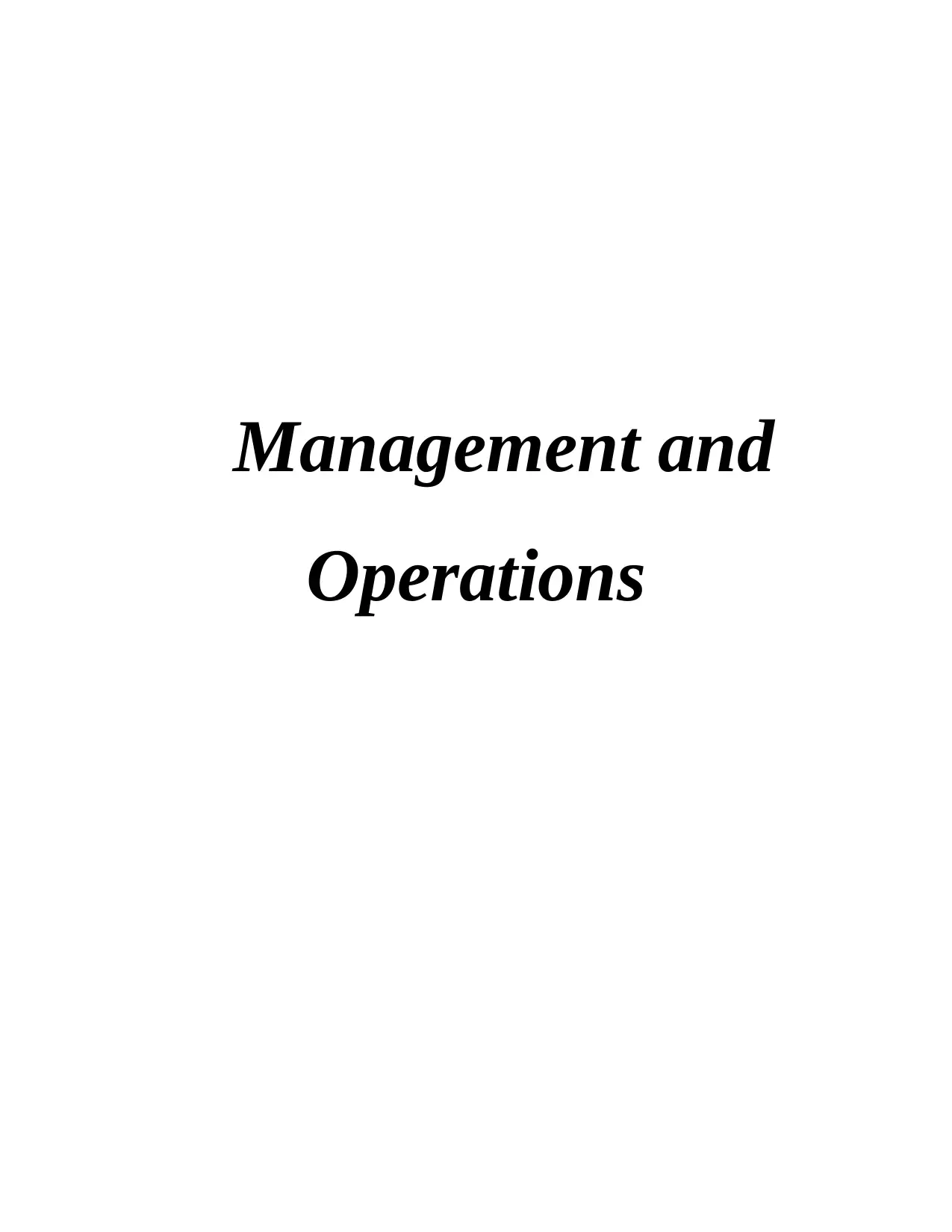
Management and
Operations
Operations
Paraphrase This Document
Need a fresh take? Get an instant paraphrase of this document with our AI Paraphraser
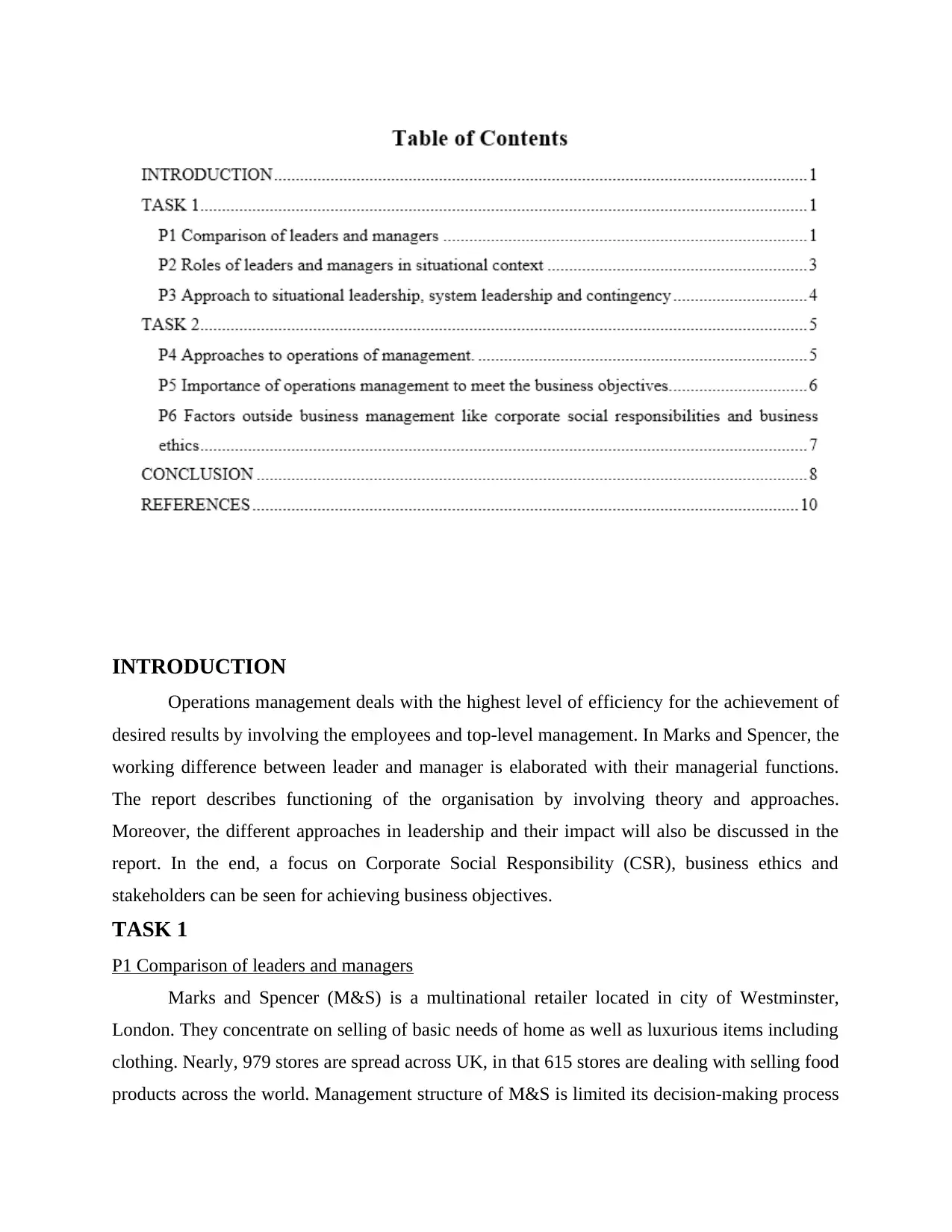
INTRODUCTION
Operations management deals with the highest level of efficiency for the achievement of
desired results by involving the employees and top-level management. In Marks and Spencer, the
working difference between leader and manager is elaborated with their managerial functions.
The report describes functioning of the organisation by involving theory and approaches.
Moreover, the different approaches in leadership and their impact will also be discussed in the
report. In the end, a focus on Corporate Social Responsibility (CSR), business ethics and
stakeholders can be seen for achieving business objectives.
TASK 1
P1 Comparison of leaders and managers
Marks and Spencer (M&S) is a multinational retailer located in city of Westminster,
London. They concentrate on selling of basic needs of home as well as luxurious items including
clothing. Nearly, 979 stores are spread across UK, in that 615 stores are dealing with selling food
products across the world. Management structure of M&S is limited its decision-making process
Operations management deals with the highest level of efficiency for the achievement of
desired results by involving the employees and top-level management. In Marks and Spencer, the
working difference between leader and manager is elaborated with their managerial functions.
The report describes functioning of the organisation by involving theory and approaches.
Moreover, the different approaches in leadership and their impact will also be discussed in the
report. In the end, a focus on Corporate Social Responsibility (CSR), business ethics and
stakeholders can be seen for achieving business objectives.
TASK 1
P1 Comparison of leaders and managers
Marks and Spencer (M&S) is a multinational retailer located in city of Westminster,
London. They concentrate on selling of basic needs of home as well as luxurious items including
clothing. Nearly, 979 stores are spread across UK, in that 615 stores are dealing with selling food
products across the world. Management structure of M&S is limited its decision-making process
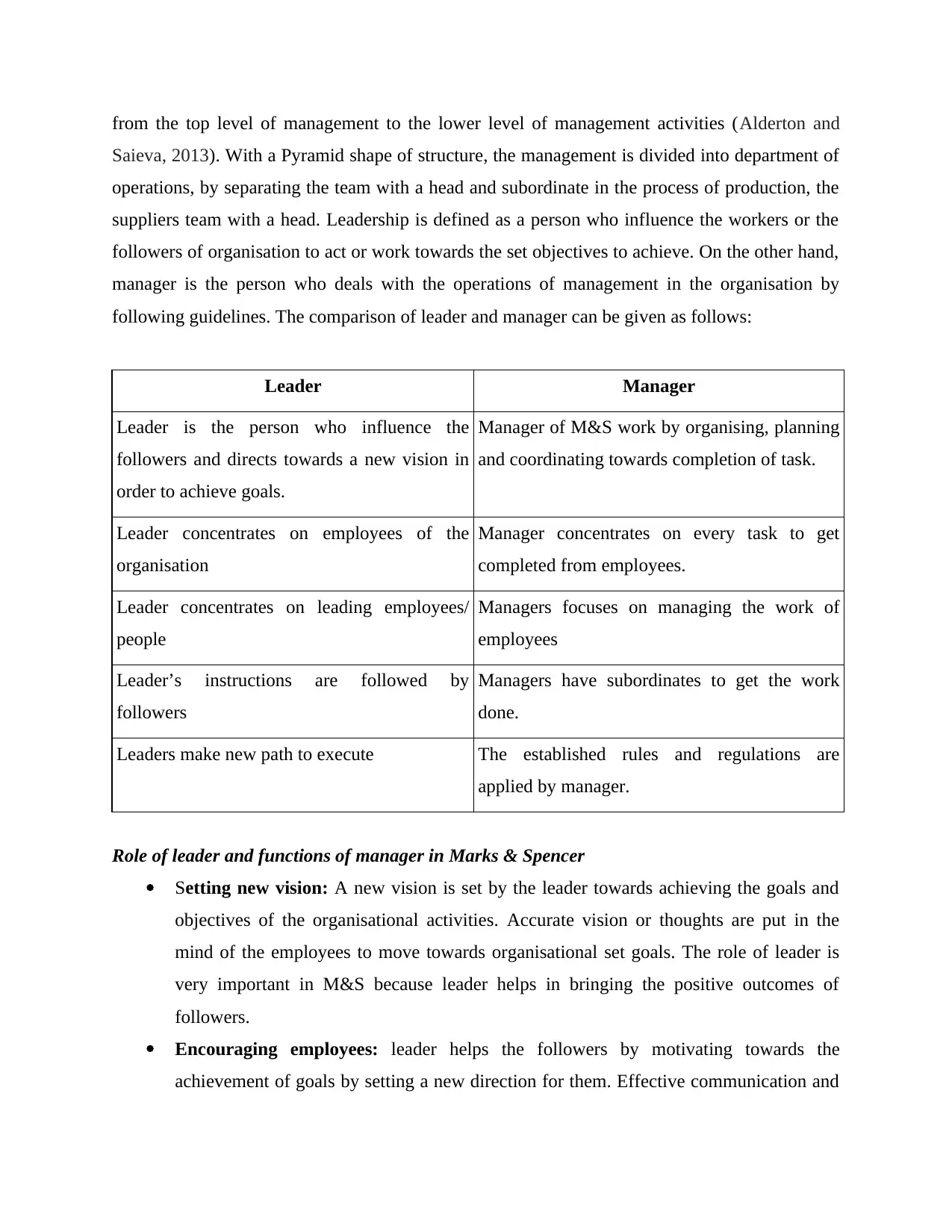
from the top level of management to the lower level of management activities (Alderton and
Saieva, 2013). With a Pyramid shape of structure, the management is divided into department of
operations, by separating the team with a head and subordinate in the process of production, the
suppliers team with a head. Leadership is defined as a person who influence the workers or the
followers of organisation to act or work towards the set objectives to achieve. On the other hand,
manager is the person who deals with the operations of management in the organisation by
following guidelines. The comparison of leader and manager can be given as follows:
Leader Manager
Leader is the person who influence the
followers and directs towards a new vision in
order to achieve goals.
Manager of M&S work by organising, planning
and coordinating towards completion of task.
Leader concentrates on employees of the
organisation
Manager concentrates on every task to get
completed from employees.
Leader concentrates on leading employees/
people
Managers focuses on managing the work of
employees
Leader’s instructions are followed by
followers
Managers have subordinates to get the work
done.
Leaders make new path to execute The established rules and regulations are
applied by manager.
Role of leader and functions of manager in Marks & Spencer
Setting new vision: A new vision is set by the leader towards achieving the goals and
objectives of the organisational activities. Accurate vision or thoughts are put in the
mind of the employees to move towards organisational set goals. The role of leader is
very important in M&S because leader helps in bringing the positive outcomes of
followers.
Encouraging employees: leader helps the followers by motivating towards the
achievement of goals by setting a new direction for them. Effective communication and
Saieva, 2013). With a Pyramid shape of structure, the management is divided into department of
operations, by separating the team with a head and subordinate in the process of production, the
suppliers team with a head. Leadership is defined as a person who influence the workers or the
followers of organisation to act or work towards the set objectives to achieve. On the other hand,
manager is the person who deals with the operations of management in the organisation by
following guidelines. The comparison of leader and manager can be given as follows:
Leader Manager
Leader is the person who influence the
followers and directs towards a new vision in
order to achieve goals.
Manager of M&S work by organising, planning
and coordinating towards completion of task.
Leader concentrates on employees of the
organisation
Manager concentrates on every task to get
completed from employees.
Leader concentrates on leading employees/
people
Managers focuses on managing the work of
employees
Leader’s instructions are followed by
followers
Managers have subordinates to get the work
done.
Leaders make new path to execute The established rules and regulations are
applied by manager.
Role of leader and functions of manager in Marks & Spencer
Setting new vision: A new vision is set by the leader towards achieving the goals and
objectives of the organisational activities. Accurate vision or thoughts are put in the
mind of the employees to move towards organisational set goals. The role of leader is
very important in M&S because leader helps in bringing the positive outcomes of
followers.
Encouraging employees: leader helps the followers by motivating towards the
achievement of goals by setting a new direction for them. Effective communication and
⊘ This is a preview!⊘
Do you want full access?
Subscribe today to unlock all pages.

Trusted by 1+ million students worldwide
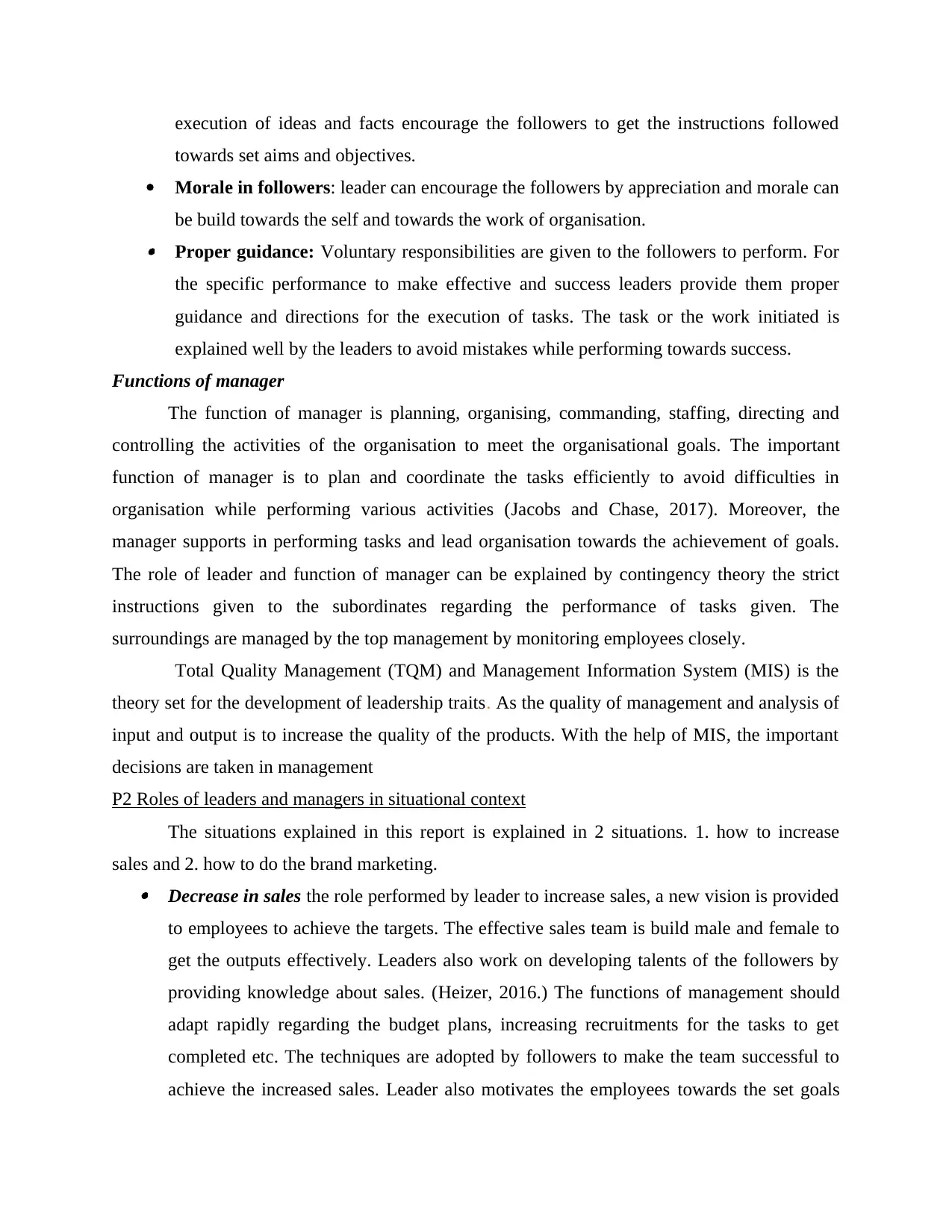
execution of ideas and facts encourage the followers to get the instructions followed
towards set aims and objectives.
Morale in followers: leader can encourage the followers by appreciation and morale can
be build towards the self and towards the work of organisation. Proper guidance: Voluntary responsibilities are given to the followers to perform. For
the specific performance to make effective and success leaders provide them proper
guidance and directions for the execution of tasks. The task or the work initiated is
explained well by the leaders to avoid mistakes while performing towards success.
Functions of manager
The function of manager is planning, organising, commanding, staffing, directing and
controlling the activities of the organisation to meet the organisational goals. The important
function of manager is to plan and coordinate the tasks efficiently to avoid difficulties in
organisation while performing various activities (Jacobs and Chase, 2017). Moreover, the
manager supports in performing tasks and lead organisation towards the achievement of goals.
The role of leader and function of manager can be explained by contingency theory the strict
instructions given to the subordinates regarding the performance of tasks given. The
surroundings are managed by the top management by monitoring employees closely.
Total Quality Management (TQM) and Management Information System (MIS) is the
theory set for the development of leadership traits. As the quality of management and analysis of
input and output is to increase the quality of the products. With the help of MIS, the important
decisions are taken in management
P2 Roles of leaders and managers in situational context
The situations explained in this report is explained in 2 situations. 1. how to increase
sales and 2. how to do the brand marketing. Decrease in sales the role performed by leader to increase sales, a new vision is provided
to employees to achieve the targets. The effective sales team is build male and female to
get the outputs effectively. Leaders also work on developing talents of the followers by
providing knowledge about sales. (Heizer, 2016.) The functions of management should
adapt rapidly regarding the budget plans, increasing recruitments for the tasks to get
completed etc. The techniques are adopted by followers to make the team successful to
achieve the increased sales. Leader also motivates the employees towards the set goals
towards set aims and objectives.
Morale in followers: leader can encourage the followers by appreciation and morale can
be build towards the self and towards the work of organisation. Proper guidance: Voluntary responsibilities are given to the followers to perform. For
the specific performance to make effective and success leaders provide them proper
guidance and directions for the execution of tasks. The task or the work initiated is
explained well by the leaders to avoid mistakes while performing towards success.
Functions of manager
The function of manager is planning, organising, commanding, staffing, directing and
controlling the activities of the organisation to meet the organisational goals. The important
function of manager is to plan and coordinate the tasks efficiently to avoid difficulties in
organisation while performing various activities (Jacobs and Chase, 2017). Moreover, the
manager supports in performing tasks and lead organisation towards the achievement of goals.
The role of leader and function of manager can be explained by contingency theory the strict
instructions given to the subordinates regarding the performance of tasks given. The
surroundings are managed by the top management by monitoring employees closely.
Total Quality Management (TQM) and Management Information System (MIS) is the
theory set for the development of leadership traits. As the quality of management and analysis of
input and output is to increase the quality of the products. With the help of MIS, the important
decisions are taken in management
P2 Roles of leaders and managers in situational context
The situations explained in this report is explained in 2 situations. 1. how to increase
sales and 2. how to do the brand marketing. Decrease in sales the role performed by leader to increase sales, a new vision is provided
to employees to achieve the targets. The effective sales team is build male and female to
get the outputs effectively. Leaders also work on developing talents of the followers by
providing knowledge about sales. (Heizer, 2016.) The functions of management should
adapt rapidly regarding the budget plans, increasing recruitments for the tasks to get
completed etc. The techniques are adopted by followers to make the team successful to
achieve the increased sales. Leader also motivates the employees towards the set goals
Paraphrase This Document
Need a fresh take? Get an instant paraphrase of this document with our AI Paraphraser
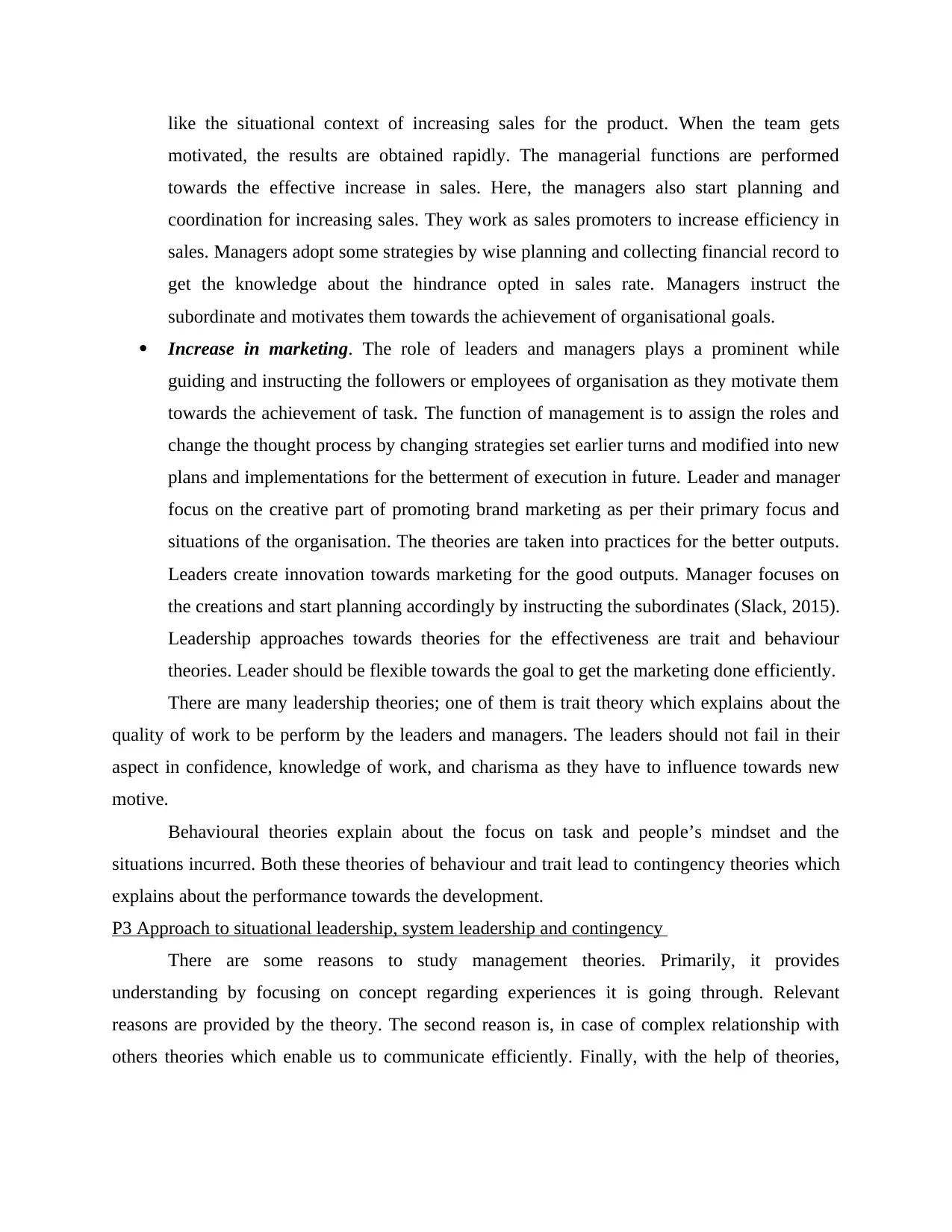
like the situational context of increasing sales for the product. When the team gets
motivated, the results are obtained rapidly. The managerial functions are performed
towards the effective increase in sales. Here, the managers also start planning and
coordination for increasing sales. They work as sales promoters to increase efficiency in
sales. Managers adopt some strategies by wise planning and collecting financial record to
get the knowledge about the hindrance opted in sales rate. Managers instruct the
subordinate and motivates them towards the achievement of organisational goals.
Increase in marketing. The role of leaders and managers plays a prominent while
guiding and instructing the followers or employees of organisation as they motivate them
towards the achievement of task. The function of management is to assign the roles and
change the thought process by changing strategies set earlier turns and modified into new
plans and implementations for the betterment of execution in future. Leader and manager
focus on the creative part of promoting brand marketing as per their primary focus and
situations of the organisation. The theories are taken into practices for the better outputs.
Leaders create innovation towards marketing for the good outputs. Manager focuses on
the creations and start planning accordingly by instructing the subordinates (Slack, 2015).
Leadership approaches towards theories for the effectiveness are trait and behaviour
theories. Leader should be flexible towards the goal to get the marketing done efficiently.
There are many leadership theories; one of them is trait theory which explains about the
quality of work to be perform by the leaders and managers. The leaders should not fail in their
aspect in confidence, knowledge of work, and charisma as they have to influence towards new
motive.
Behavioural theories explain about the focus on task and people’s mindset and the
situations incurred. Both these theories of behaviour and trait lead to contingency theories which
explains about the performance towards the development.
P3 Approach to situational leadership, system leadership and contingency
There are some reasons to study management theories. Primarily, it provides
understanding by focusing on concept regarding experiences it is going through. Relevant
reasons are provided by the theory. The second reason is, in case of complex relationship with
others theories which enable us to communicate efficiently. Finally, with the help of theories,
motivated, the results are obtained rapidly. The managerial functions are performed
towards the effective increase in sales. Here, the managers also start planning and
coordination for increasing sales. They work as sales promoters to increase efficiency in
sales. Managers adopt some strategies by wise planning and collecting financial record to
get the knowledge about the hindrance opted in sales rate. Managers instruct the
subordinate and motivates them towards the achievement of organisational goals.
Increase in marketing. The role of leaders and managers plays a prominent while
guiding and instructing the followers or employees of organisation as they motivate them
towards the achievement of task. The function of management is to assign the roles and
change the thought process by changing strategies set earlier turns and modified into new
plans and implementations for the betterment of execution in future. Leader and manager
focus on the creative part of promoting brand marketing as per their primary focus and
situations of the organisation. The theories are taken into practices for the better outputs.
Leaders create innovation towards marketing for the good outputs. Manager focuses on
the creations and start planning accordingly by instructing the subordinates (Slack, 2015).
Leadership approaches towards theories for the effectiveness are trait and behaviour
theories. Leader should be flexible towards the goal to get the marketing done efficiently.
There are many leadership theories; one of them is trait theory which explains about the
quality of work to be perform by the leaders and managers. The leaders should not fail in their
aspect in confidence, knowledge of work, and charisma as they have to influence towards new
motive.
Behavioural theories explain about the focus on task and people’s mindset and the
situations incurred. Both these theories of behaviour and trait lead to contingency theories which
explains about the performance towards the development.
P3 Approach to situational leadership, system leadership and contingency
There are some reasons to study management theories. Primarily, it provides
understanding by focusing on concept regarding experiences it is going through. Relevant
reasons are provided by the theory. The second reason is, in case of complex relationship with
others theories which enable us to communicate efficiently. Finally, with the help of theories,
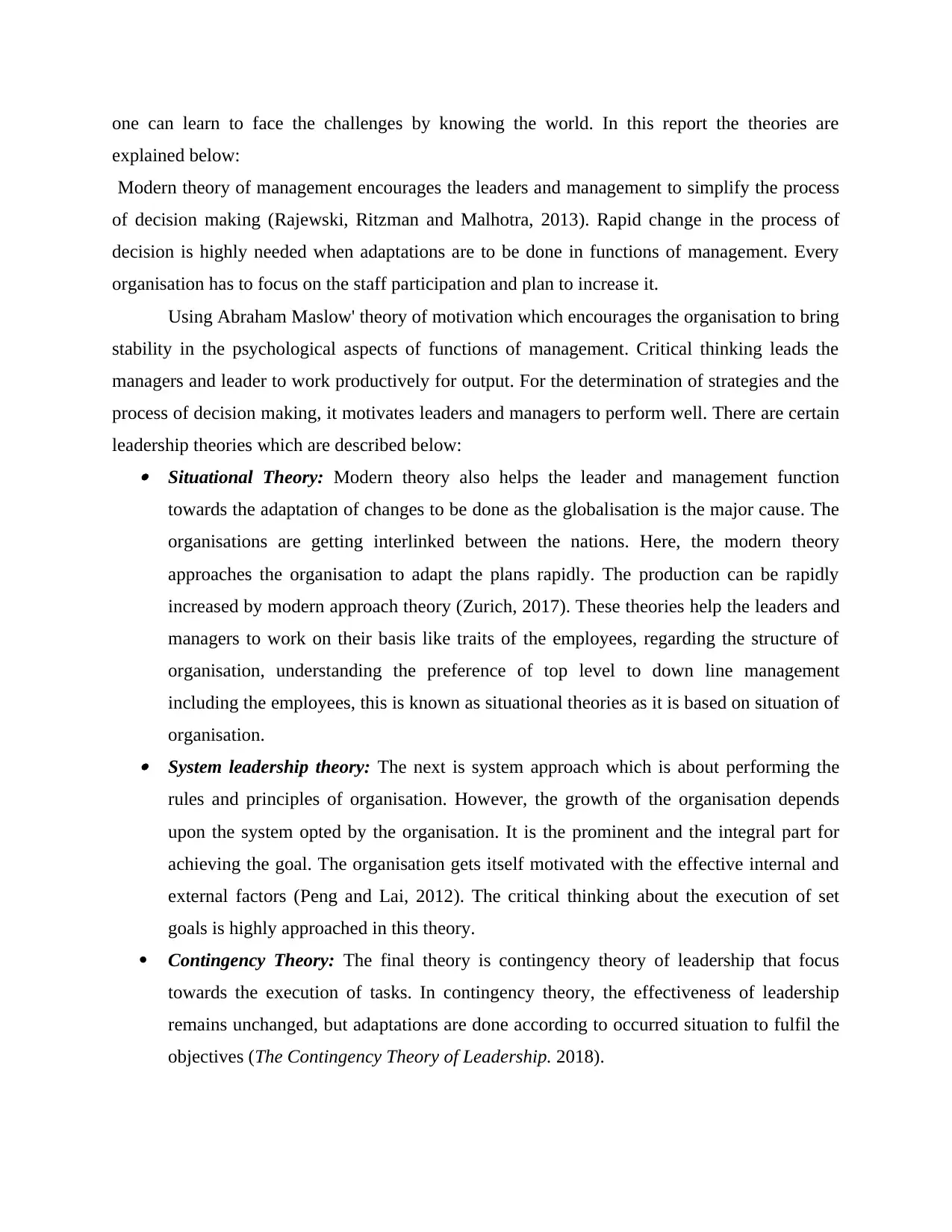
one can learn to face the challenges by knowing the world. In this report the theories are
explained below:
Modern theory of management encourages the leaders and management to simplify the process
of decision making (Rajewski, Ritzman and Malhotra, 2013). Rapid change in the process of
decision is highly needed when adaptations are to be done in functions of management. Every
organisation has to focus on the staff participation and plan to increase it.
Using Abraham Maslow' theory of motivation which encourages the organisation to bring
stability in the psychological aspects of functions of management. Critical thinking leads the
managers and leader to work productively for output. For the determination of strategies and the
process of decision making, it motivates leaders and managers to perform well. There are certain
leadership theories which are described below: Situational Theory: Modern theory also helps the leader and management function
towards the adaptation of changes to be done as the globalisation is the major cause. The
organisations are getting interlinked between the nations. Here, the modern theory
approaches the organisation to adapt the plans rapidly. The production can be rapidly
increased by modern approach theory (Zurich, 2017). These theories help the leaders and
managers to work on their basis like traits of the employees, regarding the structure of
organisation, understanding the preference of top level to down line management
including the employees, this is known as situational theories as it is based on situation of
organisation. System leadership theory: The next is system approach which is about performing the
rules and principles of organisation. However, the growth of the organisation depends
upon the system opted by the organisation. It is the prominent and the integral part for
achieving the goal. The organisation gets itself motivated with the effective internal and
external factors (Peng and Lai, 2012). The critical thinking about the execution of set
goals is highly approached in this theory.
Contingency Theory: The final theory is contingency theory of leadership that focus
towards the execution of tasks. In contingency theory, the effectiveness of leadership
remains unchanged, but adaptations are done according to occurred situation to fulfil the
objectives (The Contingency Theory of Leadership. 2018).
explained below:
Modern theory of management encourages the leaders and management to simplify the process
of decision making (Rajewski, Ritzman and Malhotra, 2013). Rapid change in the process of
decision is highly needed when adaptations are to be done in functions of management. Every
organisation has to focus on the staff participation and plan to increase it.
Using Abraham Maslow' theory of motivation which encourages the organisation to bring
stability in the psychological aspects of functions of management. Critical thinking leads the
managers and leader to work productively for output. For the determination of strategies and the
process of decision making, it motivates leaders and managers to perform well. There are certain
leadership theories which are described below: Situational Theory: Modern theory also helps the leader and management function
towards the adaptation of changes to be done as the globalisation is the major cause. The
organisations are getting interlinked between the nations. Here, the modern theory
approaches the organisation to adapt the plans rapidly. The production can be rapidly
increased by modern approach theory (Zurich, 2017). These theories help the leaders and
managers to work on their basis like traits of the employees, regarding the structure of
organisation, understanding the preference of top level to down line management
including the employees, this is known as situational theories as it is based on situation of
organisation. System leadership theory: The next is system approach which is about performing the
rules and principles of organisation. However, the growth of the organisation depends
upon the system opted by the organisation. It is the prominent and the integral part for
achieving the goal. The organisation gets itself motivated with the effective internal and
external factors (Peng and Lai, 2012). The critical thinking about the execution of set
goals is highly approached in this theory.
Contingency Theory: The final theory is contingency theory of leadership that focus
towards the execution of tasks. In contingency theory, the effectiveness of leadership
remains unchanged, but adaptations are done according to occurred situation to fulfil the
objectives (The Contingency Theory of Leadership. 2018).
⊘ This is a preview!⊘
Do you want full access?
Subscribe today to unlock all pages.

Trusted by 1+ million students worldwide
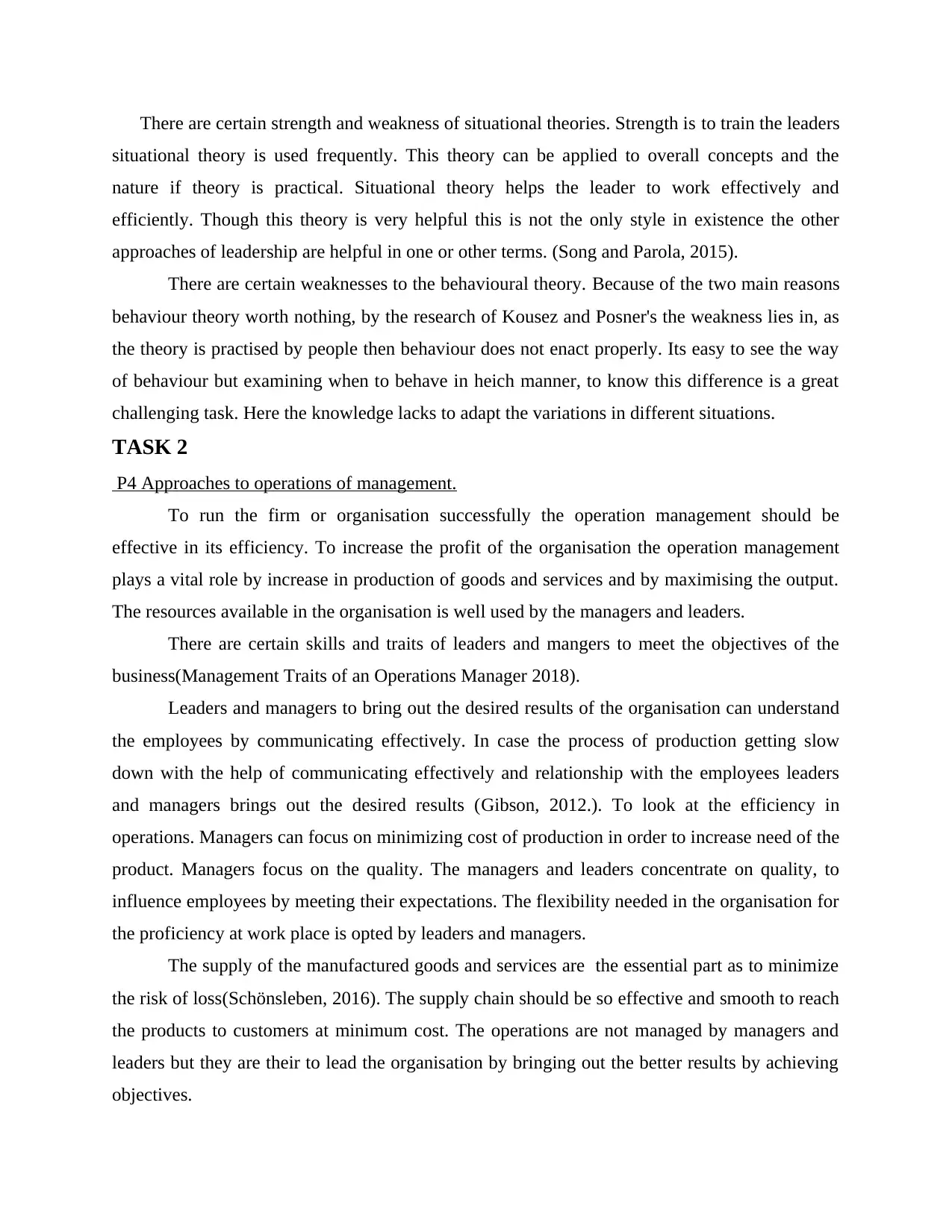
There are certain strength and weakness of situational theories. Strength is to train the leaders
situational theory is used frequently. This theory can be applied to overall concepts and the
nature if theory is practical. Situational theory helps the leader to work effectively and
efficiently. Though this theory is very helpful this is not the only style in existence the other
approaches of leadership are helpful in one or other terms. (Song and Parola, 2015).
There are certain weaknesses to the behavioural theory. Because of the two main reasons
behaviour theory worth nothing, by the research of Kousez and Posner's the weakness lies in, as
the theory is practised by people then behaviour does not enact properly. Its easy to see the way
of behaviour but examining when to behave in heich manner, to know this difference is a great
challenging task. Here the knowledge lacks to adapt the variations in different situations.
TASK 2
P4 Approaches to operations of management.
To run the firm or organisation successfully the operation management should be
effective in its efficiency. To increase the profit of the organisation the operation management
plays a vital role by increase in production of goods and services and by maximising the output.
The resources available in the organisation is well used by the managers and leaders.
There are certain skills and traits of leaders and mangers to meet the objectives of the
business(Management Traits of an Operations Manager 2018).
Leaders and managers to bring out the desired results of the organisation can understand
the employees by communicating effectively. In case the process of production getting slow
down with the help of communicating effectively and relationship with the employees leaders
and managers brings out the desired results (Gibson, 2012.). To look at the efficiency in
operations. Managers can focus on minimizing cost of production in order to increase need of the
product. Managers focus on the quality. The managers and leaders concentrate on quality, to
influence employees by meeting their expectations. The flexibility needed in the organisation for
the proficiency at work place is opted by leaders and managers.
The supply of the manufactured goods and services are the essential part as to minimize
the risk of loss(Schönsleben, 2016). The supply chain should be so effective and smooth to reach
the products to customers at minimum cost. The operations are not managed by managers and
leaders but they are their to lead the organisation by bringing out the better results by achieving
objectives.
situational theory is used frequently. This theory can be applied to overall concepts and the
nature if theory is practical. Situational theory helps the leader to work effectively and
efficiently. Though this theory is very helpful this is not the only style in existence the other
approaches of leadership are helpful in one or other terms. (Song and Parola, 2015).
There are certain weaknesses to the behavioural theory. Because of the two main reasons
behaviour theory worth nothing, by the research of Kousez and Posner's the weakness lies in, as
the theory is practised by people then behaviour does not enact properly. Its easy to see the way
of behaviour but examining when to behave in heich manner, to know this difference is a great
challenging task. Here the knowledge lacks to adapt the variations in different situations.
TASK 2
P4 Approaches to operations of management.
To run the firm or organisation successfully the operation management should be
effective in its efficiency. To increase the profit of the organisation the operation management
plays a vital role by increase in production of goods and services and by maximising the output.
The resources available in the organisation is well used by the managers and leaders.
There are certain skills and traits of leaders and mangers to meet the objectives of the
business(Management Traits of an Operations Manager 2018).
Leaders and managers to bring out the desired results of the organisation can understand
the employees by communicating effectively. In case the process of production getting slow
down with the help of communicating effectively and relationship with the employees leaders
and managers brings out the desired results (Gibson, 2012.). To look at the efficiency in
operations. Managers can focus on minimizing cost of production in order to increase need of the
product. Managers focus on the quality. The managers and leaders concentrate on quality, to
influence employees by meeting their expectations. The flexibility needed in the organisation for
the proficiency at work place is opted by leaders and managers.
The supply of the manufactured goods and services are the essential part as to minimize
the risk of loss(Schönsleben, 2016). The supply chain should be so effective and smooth to reach
the products to customers at minimum cost. The operations are not managed by managers and
leaders but they are their to lead the organisation by bringing out the better results by achieving
objectives.
Paraphrase This Document
Need a fresh take? Get an instant paraphrase of this document with our AI Paraphraser
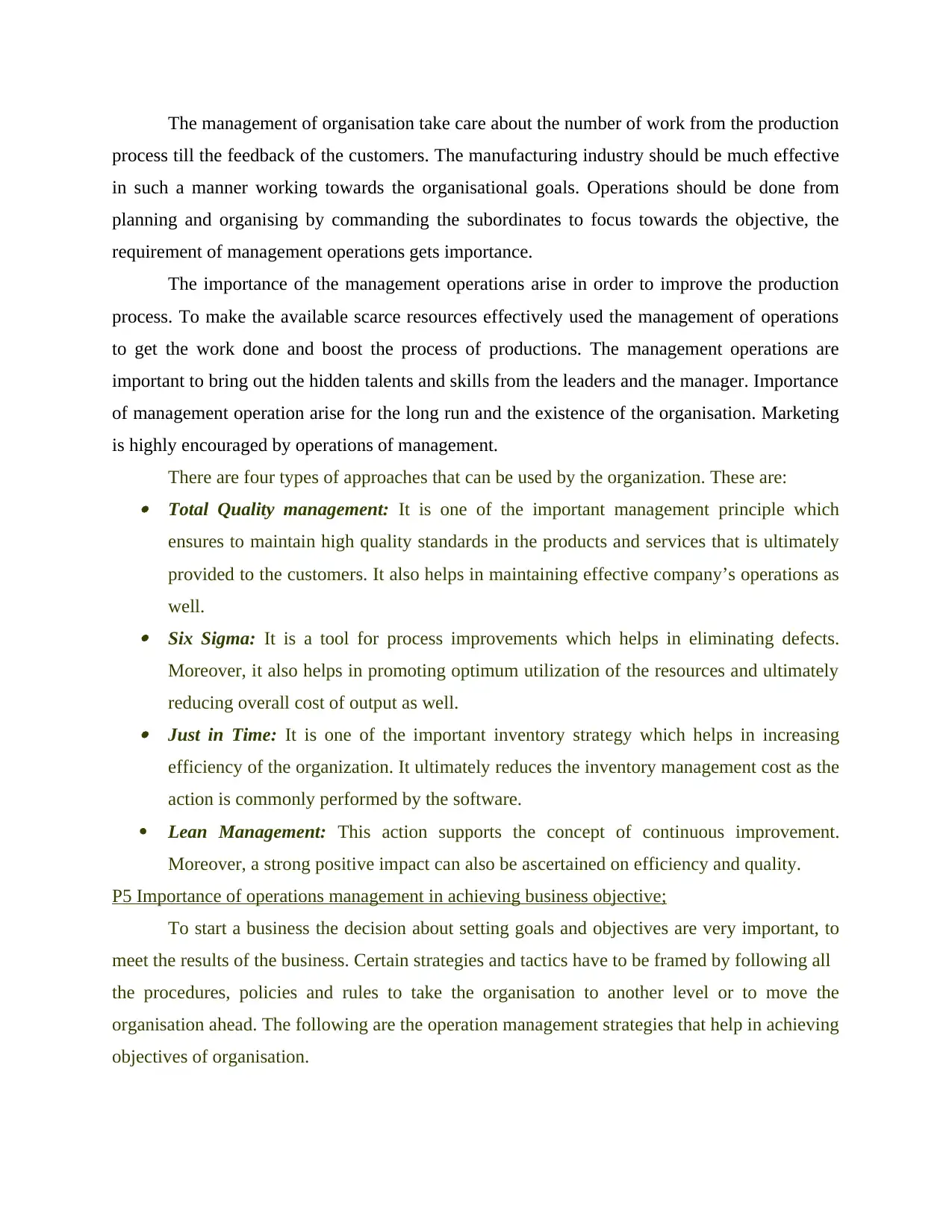
The management of organisation take care about the number of work from the production
process till the feedback of the customers. The manufacturing industry should be much effective
in such a manner working towards the organisational goals. Operations should be done from
planning and organising by commanding the subordinates to focus towards the objective, the
requirement of management operations gets importance.
The importance of the management operations arise in order to improve the production
process. To make the available scarce resources effectively used the management of operations
to get the work done and boost the process of productions. The management operations are
important to bring out the hidden talents and skills from the leaders and the manager. Importance
of management operation arise for the long run and the existence of the organisation. Marketing
is highly encouraged by operations of management.
There are four types of approaches that can be used by the organization. These are: Total Quality management: It is one of the important management principle which
ensures to maintain high quality standards in the products and services that is ultimately
provided to the customers. It also helps in maintaining effective company’s operations as
well. Six Sigma: It is a tool for process improvements which helps in eliminating defects.
Moreover, it also helps in promoting optimum utilization of the resources and ultimately
reducing overall cost of output as well. Just in Time: It is one of the important inventory strategy which helps in increasing
efficiency of the organization. It ultimately reduces the inventory management cost as the
action is commonly performed by the software.
Lean Management: This action supports the concept of continuous improvement.
Moreover, a strong positive impact can also be ascertained on efficiency and quality.
P5 Importance of operations management in achieving business objective;
To start a business the decision about setting goals and objectives are very important, to
meet the results of the business. Certain strategies and tactics have to be framed by following all
the procedures, policies and rules to take the organisation to another level or to move the
organisation ahead. The following are the operation management strategies that help in achieving
objectives of organisation.
process till the feedback of the customers. The manufacturing industry should be much effective
in such a manner working towards the organisational goals. Operations should be done from
planning and organising by commanding the subordinates to focus towards the objective, the
requirement of management operations gets importance.
The importance of the management operations arise in order to improve the production
process. To make the available scarce resources effectively used the management of operations
to get the work done and boost the process of productions. The management operations are
important to bring out the hidden talents and skills from the leaders and the manager. Importance
of management operation arise for the long run and the existence of the organisation. Marketing
is highly encouraged by operations of management.
There are four types of approaches that can be used by the organization. These are: Total Quality management: It is one of the important management principle which
ensures to maintain high quality standards in the products and services that is ultimately
provided to the customers. It also helps in maintaining effective company’s operations as
well. Six Sigma: It is a tool for process improvements which helps in eliminating defects.
Moreover, it also helps in promoting optimum utilization of the resources and ultimately
reducing overall cost of output as well. Just in Time: It is one of the important inventory strategy which helps in increasing
efficiency of the organization. It ultimately reduces the inventory management cost as the
action is commonly performed by the software.
Lean Management: This action supports the concept of continuous improvement.
Moreover, a strong positive impact can also be ascertained on efficiency and quality.
P5 Importance of operations management in achieving business objective;
To start a business the decision about setting goals and objectives are very important, to
meet the results of the business. Certain strategies and tactics have to be framed by following all
the procedures, policies and rules to take the organisation to another level or to move the
organisation ahead. The following are the operation management strategies that help in achieving
objectives of organisation.
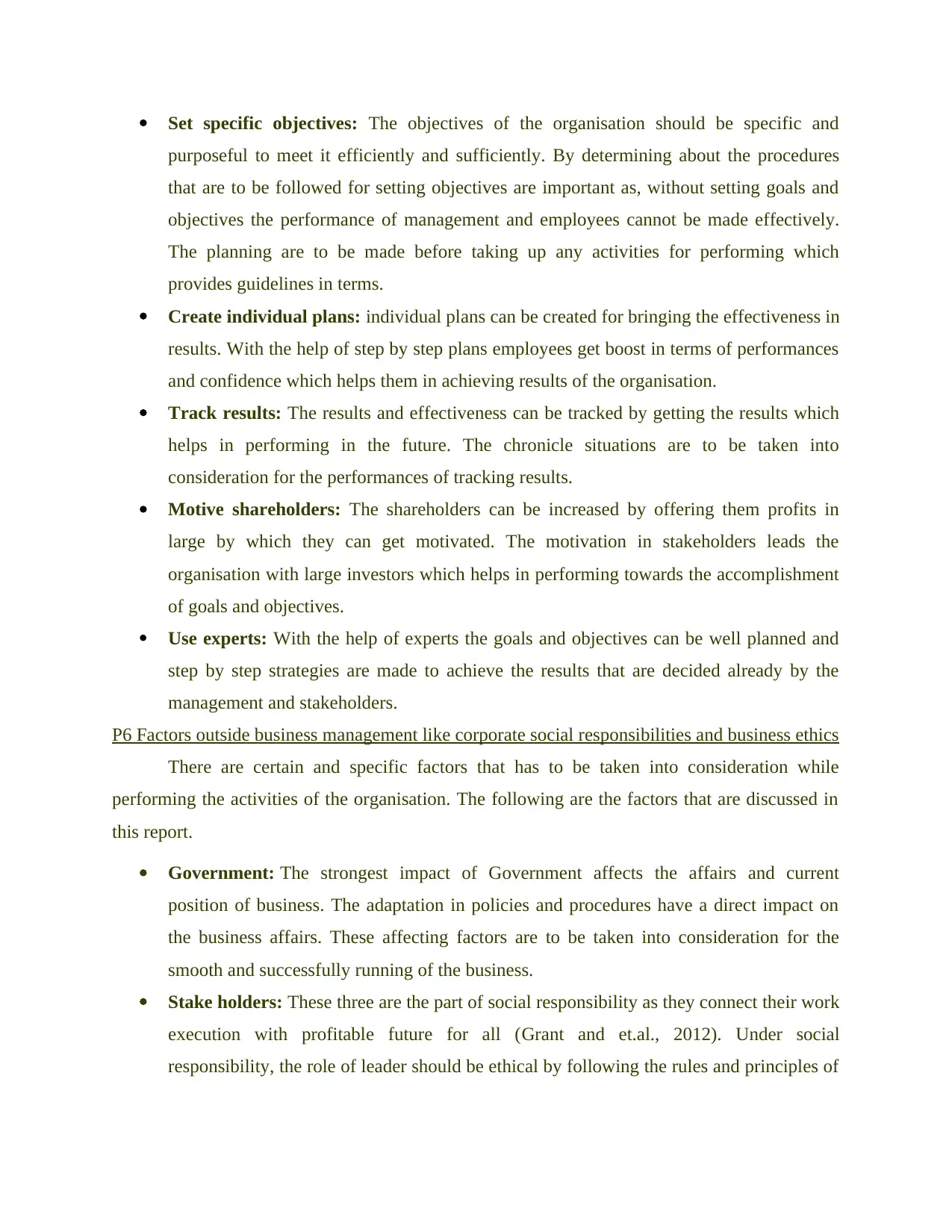
Set specific objectives: The objectives of the organisation should be specific and
purposeful to meet it efficiently and sufficiently. By determining about the procedures
that are to be followed for setting objectives are important as, without setting goals and
objectives the performance of management and employees cannot be made effectively.
The planning are to be made before taking up any activities for performing which
provides guidelines in terms.
Create individual plans: individual plans can be created for bringing the effectiveness in
results. With the help of step by step plans employees get boost in terms of performances
and confidence which helps them in achieving results of the organisation.
Track results: The results and effectiveness can be tracked by getting the results which
helps in performing in the future. The chronicle situations are to be taken into
consideration for the performances of tracking results.
Motive shareholders: The shareholders can be increased by offering them profits in
large by which they can get motivated. The motivation in stakeholders leads the
organisation with large investors which helps in performing towards the accomplishment
of goals and objectives.
Use experts: With the help of experts the goals and objectives can be well planned and
step by step strategies are made to achieve the results that are decided already by the
management and stakeholders.
P6 Factors outside business management like corporate social responsibilities and business ethics
There are certain and specific factors that has to be taken into consideration while
performing the activities of the organisation. The following are the factors that are discussed in
this report.
Government: The strongest impact of Government affects the affairs and current
position of business. The adaptation in policies and procedures have a direct impact on
the business affairs. These affecting factors are to be taken into consideration for the
smooth and successfully running of the business.
Stake holders: These three are the part of social responsibility as they connect their work
execution with profitable future for all (Grant and et.al., 2012). Under social
responsibility, the role of leader should be ethical by following the rules and principles of
purposeful to meet it efficiently and sufficiently. By determining about the procedures
that are to be followed for setting objectives are important as, without setting goals and
objectives the performance of management and employees cannot be made effectively.
The planning are to be made before taking up any activities for performing which
provides guidelines in terms.
Create individual plans: individual plans can be created for bringing the effectiveness in
results. With the help of step by step plans employees get boost in terms of performances
and confidence which helps them in achieving results of the organisation.
Track results: The results and effectiveness can be tracked by getting the results which
helps in performing in the future. The chronicle situations are to be taken into
consideration for the performances of tracking results.
Motive shareholders: The shareholders can be increased by offering them profits in
large by which they can get motivated. The motivation in stakeholders leads the
organisation with large investors which helps in performing towards the accomplishment
of goals and objectives.
Use experts: With the help of experts the goals and objectives can be well planned and
step by step strategies are made to achieve the results that are decided already by the
management and stakeholders.
P6 Factors outside business management like corporate social responsibilities and business ethics
There are certain and specific factors that has to be taken into consideration while
performing the activities of the organisation. The following are the factors that are discussed in
this report.
Government: The strongest impact of Government affects the affairs and current
position of business. The adaptation in policies and procedures have a direct impact on
the business affairs. These affecting factors are to be taken into consideration for the
smooth and successfully running of the business.
Stake holders: These three are the part of social responsibility as they connect their work
execution with profitable future for all (Grant and et.al., 2012). Under social
responsibility, the role of leader should be ethical by following the rules and principles of
⊘ This is a preview!⊘
Do you want full access?
Subscribe today to unlock all pages.

Trusted by 1+ million students worldwide
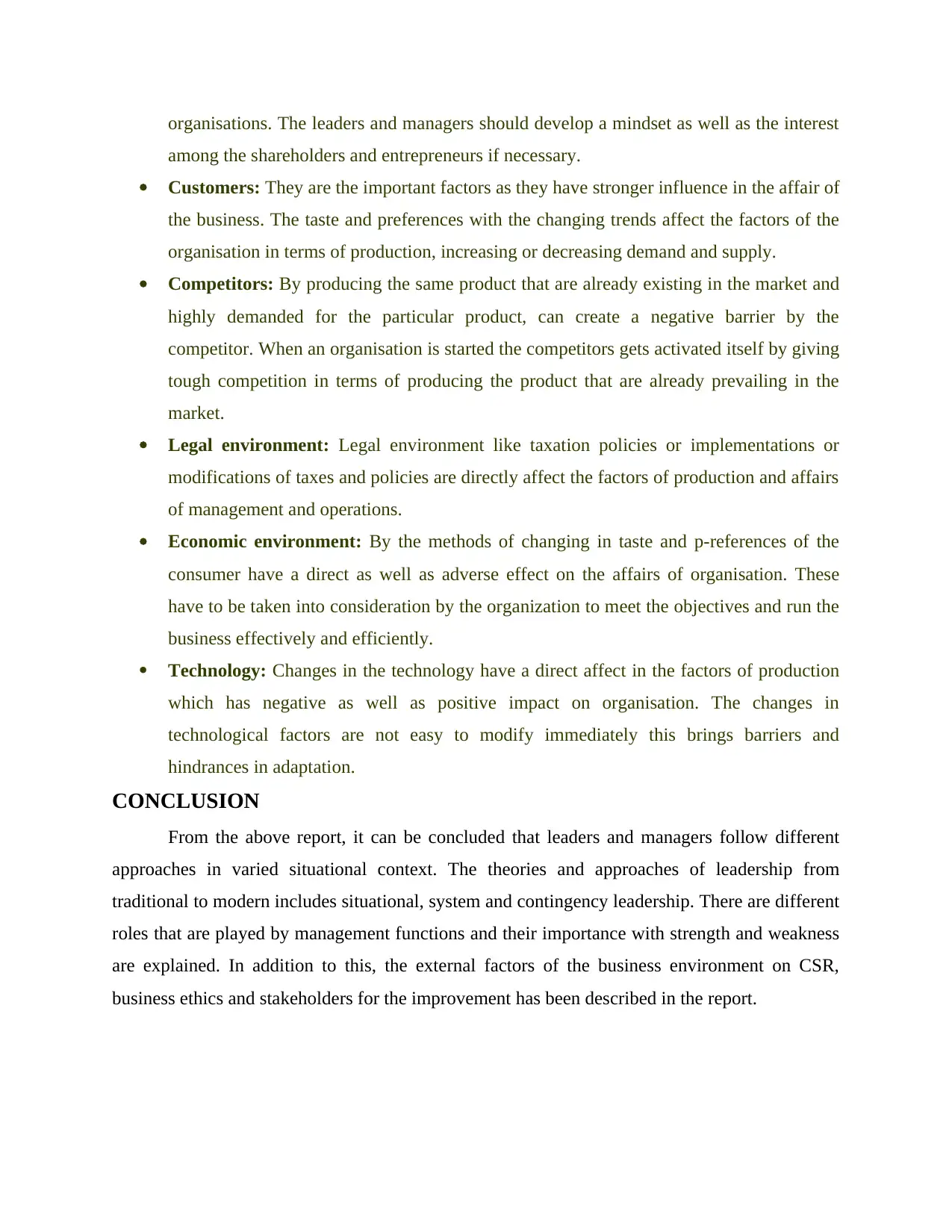
organisations. The leaders and managers should develop a mindset as well as the interest
among the shareholders and entrepreneurs if necessary.
Customers: They are the important factors as they have stronger influence in the affair of
the business. The taste and preferences with the changing trends affect the factors of the
organisation in terms of production, increasing or decreasing demand and supply.
Competitors: By producing the same product that are already existing in the market and
highly demanded for the particular product, can create a negative barrier by the
competitor. When an organisation is started the competitors gets activated itself by giving
tough competition in terms of producing the product that are already prevailing in the
market.
Legal environment: Legal environment like taxation policies or implementations or
modifications of taxes and policies are directly affect the factors of production and affairs
of management and operations.
Economic environment: By the methods of changing in taste and p-references of the
consumer have a direct as well as adverse effect on the affairs of organisation. These
have to be taken into consideration by the organization to meet the objectives and run the
business effectively and efficiently.
Technology: Changes in the technology have a direct affect in the factors of production
which has negative as well as positive impact on organisation. The changes in
technological factors are not easy to modify immediately this brings barriers and
hindrances in adaptation.
CONCLUSION
From the above report, it can be concluded that leaders and managers follow different
approaches in varied situational context. The theories and approaches of leadership from
traditional to modern includes situational, system and contingency leadership. There are different
roles that are played by management functions and their importance with strength and weakness
are explained. In addition to this, the external factors of the business environment on CSR,
business ethics and stakeholders for the improvement has been described in the report.
among the shareholders and entrepreneurs if necessary.
Customers: They are the important factors as they have stronger influence in the affair of
the business. The taste and preferences with the changing trends affect the factors of the
organisation in terms of production, increasing or decreasing demand and supply.
Competitors: By producing the same product that are already existing in the market and
highly demanded for the particular product, can create a negative barrier by the
competitor. When an organisation is started the competitors gets activated itself by giving
tough competition in terms of producing the product that are already prevailing in the
market.
Legal environment: Legal environment like taxation policies or implementations or
modifications of taxes and policies are directly affect the factors of production and affairs
of management and operations.
Economic environment: By the methods of changing in taste and p-references of the
consumer have a direct as well as adverse effect on the affairs of organisation. These
have to be taken into consideration by the organization to meet the objectives and run the
business effectively and efficiently.
Technology: Changes in the technology have a direct affect in the factors of production
which has negative as well as positive impact on organisation. The changes in
technological factors are not easy to modify immediately this brings barriers and
hindrances in adaptation.
CONCLUSION
From the above report, it can be concluded that leaders and managers follow different
approaches in varied situational context. The theories and approaches of leadership from
traditional to modern includes situational, system and contingency leadership. There are different
roles that are played by management functions and their importance with strength and weakness
are explained. In addition to this, the external factors of the business environment on CSR,
business ethics and stakeholders for the improvement has been described in the report.
Paraphrase This Document
Need a fresh take? Get an instant paraphrase of this document with our AI Paraphraser
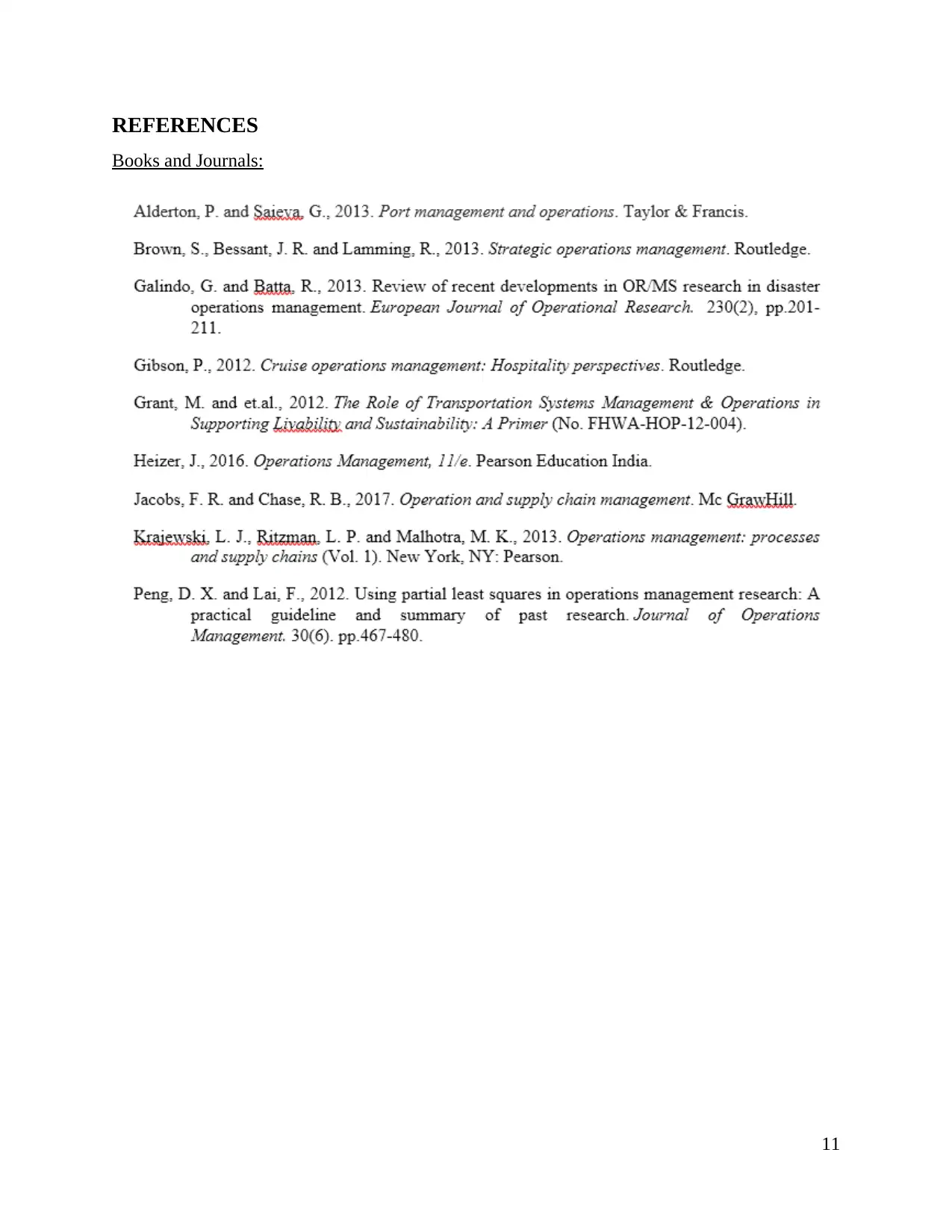
REFERENCES
Books and Journals:
11
Books and Journals:
11
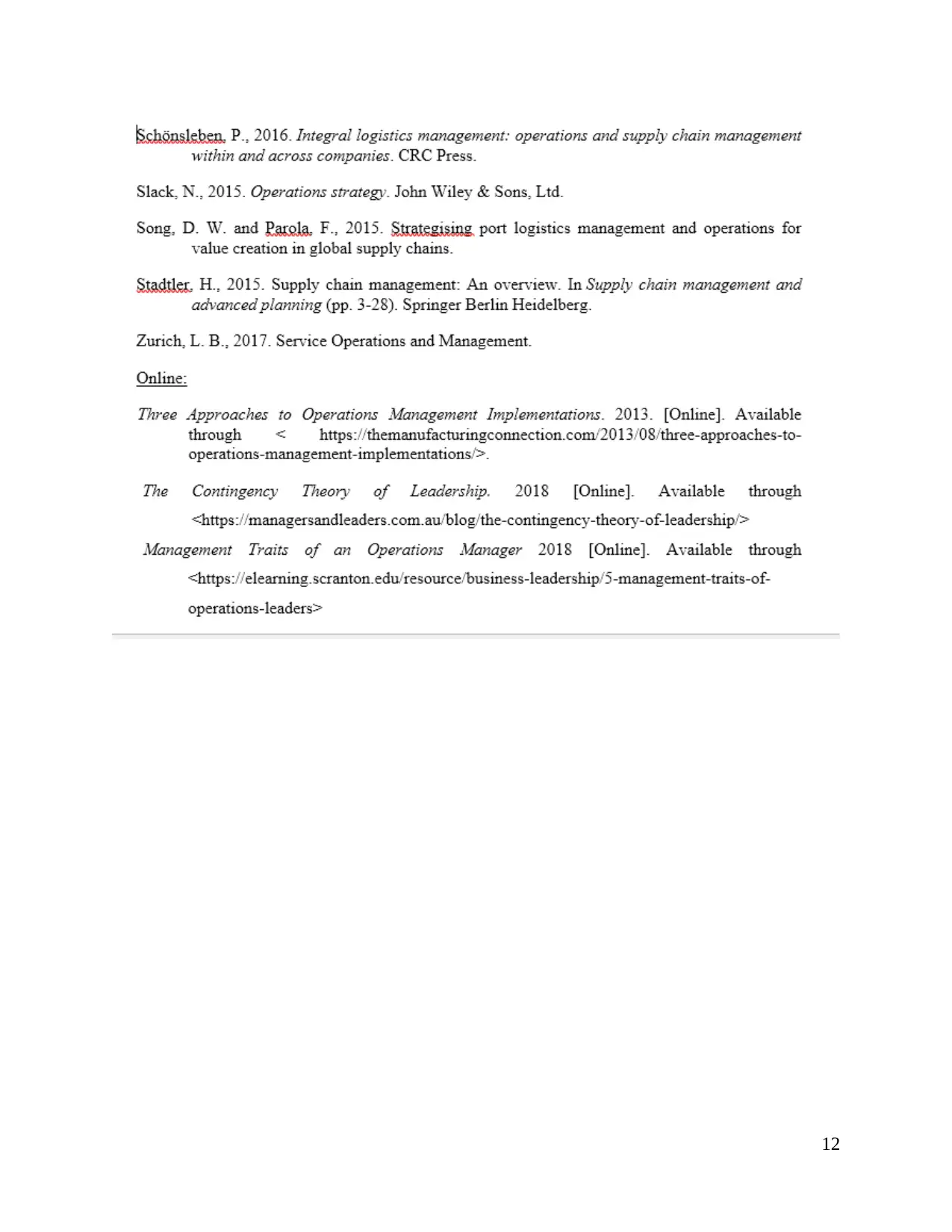
12
⊘ This is a preview!⊘
Do you want full access?
Subscribe today to unlock all pages.

Trusted by 1+ million students worldwide
1 out of 12
Related Documents
Your All-in-One AI-Powered Toolkit for Academic Success.
+13062052269
info@desklib.com
Available 24*7 on WhatsApp / Email
![[object Object]](/_next/static/media/star-bottom.7253800d.svg)
Unlock your academic potential
Copyright © 2020–2025 A2Z Services. All Rights Reserved. Developed and managed by ZUCOL.





